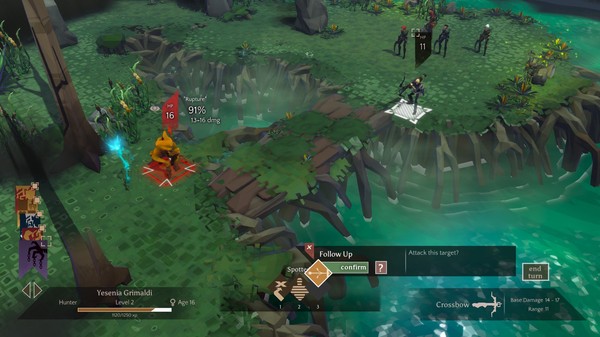
Massive Chalice, at is finest, feels like an indrawn breath, a nervous stillness punctured by the monstrous sounds of the Cadence lingering at the edge of the battlefield. As you scout ahead with your cloaked Hunters, you reach that point where your breath starts to hold, and as you lunge in with a phalanx of Caberjacks and Alchemists, giant logs and explosive flasks become the deafening shout punctuating your successful short-term strategy. It’s boisterously thrilling—even if sometimes, it’s a thrill to be felt over and over again.
That indrawn breath also follows you into the metagame—as Double Fine’s Kickstarter-backed strategy game moves out of the battlefield, you assume your spot on the throne of a kingdom bound on a 300-year journey for salvation. Your heroes, whether they be on standby for battle, or assigned to keeps to raise families, become part of a large tapestry of time where small decisions guide your efforts for “years” of in-game time. Those years translate to a matter of hours, and one campaign can prove to be as long as 18 hours of play.
Massive Chalice promotes a kind of mentality for “the greater good,” or maybe just “the longest view,” where heroes enter arranged marriages and willingly submit themselves to your matchmaking in order to raise generations of worthy soldiers. It brings you to that state in small moments, like assigning relics from parent to child, or using the tanky Caberjack characters to save the life of your elderly Sagewrights on a rescue mission.
The game’s combat finds sufficient complexity in that matchmaking system. There are only three base class units—Caberjack, Alchemist, Hunter—but assigning these heroes into relationships allows the creation of hybrid classes that blend them together and can create unique team compositions that can get you out of sticky situations. A particular favorite is the Shadowjack—a child of Hunters and Caberjacks who has the hunter’s stealth but the Caberjack’s brute force. A team of Shadowjacks, Hunters and Trickshots can move through the battlefield like ghosts and collapse on Cadence forces. Enemies also benefit from a surprising number of counterplay-focused tactics—Bulwarks break the stereotype of “ranged glass cannons,” and will armor up if you don’t land a killing blow, while ranged Lapses and melee-focused Wrinklers will sap your hero’s experience points or prematurely age them if allowed to wail on your forces.
The characters are also refreshingly diverse in other ways too. Your heroes come from a wide pool of ethnicities, and the game even supports an adoption system that allows for successful lines built on same-sex marriages. Such arrangements do come with a trade-off of research time that might be expended on other necessary projects, so heterosexual couples are still encouraged by the basic design. This part of the system may teeter on if players preferring to match same-sex relationships feel disadvantaged by needing to constantly run adoption loops instead of researching equipment.
The formula all fits the tone, which is that Celtic fantasy heroism described before. Even in only three to four mission types, (and two of them are not common occurrences), battle remains regularly compelling, especially when your squad is mixed up as frequently as it can be by the passing of years and heroes. Unlike Chalice’s turn-based cousins Fire Emblem or XCOM: Enemy Unknown, heroes dying on the battlefield doesn’t dramatically interfere with your long-term strategy, and so long as proper matchmaking is taking place, the next generation of heroes will likely be ready to replace your fallen ones even after dire conflicts.
Massive Chalice’s core design definitely strikes true for the bulk of the project, but it’s made by a smaller team at the mid-sized Double Fine studio, and its shortcomings reflect the design team’s limited size and budget. For instance, as mentioned before, there’s only a handful of mission types, and the most common of them is simply “clear the map of all enemies.” In the compressed playtime for this review, these missions could become repetitive, especially in the gaps where a bloodline’s heroes are at maximum potential power but the enemy classes haven’t begun to sufficiently advance in power or quantity.
The lack of variety also fails to suggest any connection to the people of Massive Chalice you’re supposed to be protecting. Missions are set in the woods, or swamplands, or keeps, never in villages, townships or cities. The lonely monuments in places like the wooded Augurs provide some sense of personality, but the lack of variety feels like a missed narrative opportunity, not just one of strategic variance.
And when it comes to narrative, Massive Chalice does stumble a little. Its sparse telling serves it well for the most part, but it attempts to stretch its wings in a series of random events that play out through dialogue trees that don’t feel fully fleshed out or properly paced. If Chalice were a tabletop game, they’d be cards drawn from a deck at the roll of a dice, and unfortunately a significant portion only feel like that—random cards that add a modifier to your heroes or kingdom. A failure to impress consistent personality into your ruler means wildly unexpected results to making these choices, which can sometimes feel like a punishment for embodying the game’s heroic sensibility. (Try to have your heroes educate a group of schoolchildren? Too bad, ALL your heroes are now child-averse and less likely to have kids.)
These events do succeed when they follow the wink-and-nod sense of humor that inhabits Double Fine’s other titles like Broken Age or Brutal Legend, or embody a sense of mystic weirdness that feels appropriate for a game spanning centuries, like a hero jumping into the Chalice to go back in time in search of an ancient relic. But their attempts to prop up “the people’s story” can sometimes be sadly frustrating. The game’s finale also tries to inhabit two “plot twists” simultaneously, only one of which proves somewhat satisfying, and neither is realized in literal gameplay.
But thankfully, Massive Chalice isn’t about those things. Massive Chalice is about time, about heroes, and most importantly, it’s about taking that deep breath before the strike.
Massive Chalice was developed and published by Double Fine Productions. Our review is based on the PC version. It is also available for the Xbox One.
Bryant Francis is a games writer based out of Los Angeles who’s written for Gamasutra and The Jace Hall Show. See more of his work at his website or find him on Twitter @RBryant2012.

